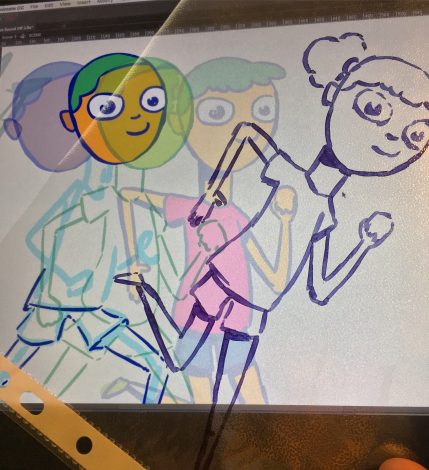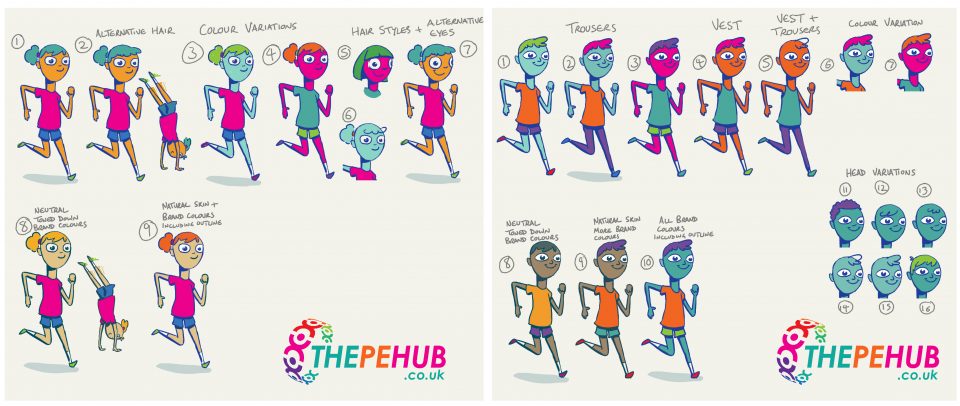The PE Hub
Animation – Louis Hudson & Nina Parker Noon
Voiceover – Suzy Fawke
Sound Design – Pete Styles
Above is one in a series of educational videos I made for an interesting company called The PE Hub who help schools improve their Physical Education by providing lesson plans. As part of their recent rebrand I was asked to create characters and make a short series of animations that break down the steps of some skills. You can see the rest of the videos on VIMEO.
It was an interesting brief that balanced colourful, fun, appealing characters that weren’t too kiddy and had the proportions to perform realistic human action.
The sound and voiceover also played into that. I asked Pete Styles to rummage about in his bag of audio magic to create some non-realistic sounds that emphasised each stage of the skills in a way that was pleasant to listen to repeatedly. He accompanied that with a simple upbeat score that left plenty of space for the sound effects. Suzy Fawke also gave a delivery that hit the enthusiastic PE teacher mark perfectly.
 The films required strong character animation to depict what was happening at each stage of the skill. I’m definitely not a gymnast so thankfully The PE Hub had filmed some reference footage.
The films required strong character animation to depict what was happening at each stage of the skill. I’m definitely not a gymnast so thankfully The PE Hub had filmed some reference footage.
These videos were then broken down to form the basis of the movement. It’s interesting that when rotoscoping footage the resulting animation tends to look a little stiff and weightless. This is partly due to the fact that it’s difficult to fully capture poses from live footage AND make it flow from frame to frame. However, the main problem is that animation is usually more exaggerated and precise than real life. Real life captured perfectly in drawings oddly feels a little lifeless.
For my intern, Nina, it was a great exercise in learning from, and then improving, real life. I’d recommend these next steps to anybody starting out in character animation.
To start, we went through each frame of the footage studying where weight was being distributed to where, drawing motion graphs, studying where things were coming from and where they were going to, and how that informed motion blur and secondary movement of the clothes. There were situations where the performer landed a little awkwardly, so we were then able to break down what his animated twin could do to land as he should.
 Next, we set the live action to 12.5fps, the same frame rate as the final animation, and rotoscoped it. We then critiqued it as a first animation pass. First any obvious bugs could be knocked out because there’s a real person with muscles and foreshortening to reference. But then the interesting stuff happens. The performance still feels like it needs punching up: pushing poses; contrast between fast and slow; somehow easing in and out was slightly off; generally finding moments to add a bit of *snap*. The difference between 25 and 12.5fps also requires a few animation tricks to fill in the gaps between the frames. Smears (or motion blur), the way cloth is dragging/bellows, and anticipation/follow through, give clues to where the missing frame was or is coming.
Next, we set the live action to 12.5fps, the same frame rate as the final animation, and rotoscoped it. We then critiqued it as a first animation pass. First any obvious bugs could be knocked out because there’s a real person with muscles and foreshortening to reference. But then the interesting stuff happens. The performance still feels like it needs punching up: pushing poses; contrast between fast and slow; somehow easing in and out was slightly off; generally finding moments to add a bit of *snap*. The difference between 25 and 12.5fps also requires a few animation tricks to fill in the gaps between the frames. Smears (or motion blur), the way cloth is dragging/bellows, and anticipation/follow through, give clues to where the missing frame was or is coming.
NOW Nina was ready to animate on model. A nice trick I developed was to have the model drawn on a plastic sheet so it could be drawn through onto the Cintiq. Getting to know a new character is a nightmare so anything that helps is always welcome. It’s a variation on how it’s done the traditional way, and it was nice to have a method that was actually easier than a digital one.
After repeating that process 3-4 times Nina was knocking it out of the park.
On a side note to interning, I tried an approach I hadn’t done before with Nina. I don’t take on many interns, so I treated it much more as a paid 4 week apprenticeship. Nina did 4 days working on this project, and 1 day working on her own personal development. That could be anything she wanted, whether it was software-based, building a website, filmmaking skills, or professional practise. Considering she was finishing her graduation film we decided to go through what she could do to make it stronger and develop the skills needed to do that.
I think this approach really worked for both of us. It created a buzz in the studio and a focus on the PE Hub work. It was also a chance to invest in an intern that would hopefully have a longer term impact. There’s always a point in an animated project where it essentially becomes creative admin. This method kept the whole process fun AND we finished way ahead of schedule, which meant Nina got to do even more on her film. I recommend it if you ever work with internships.
Here’s some of the other films we made which Nina did most of the grunt work on:


